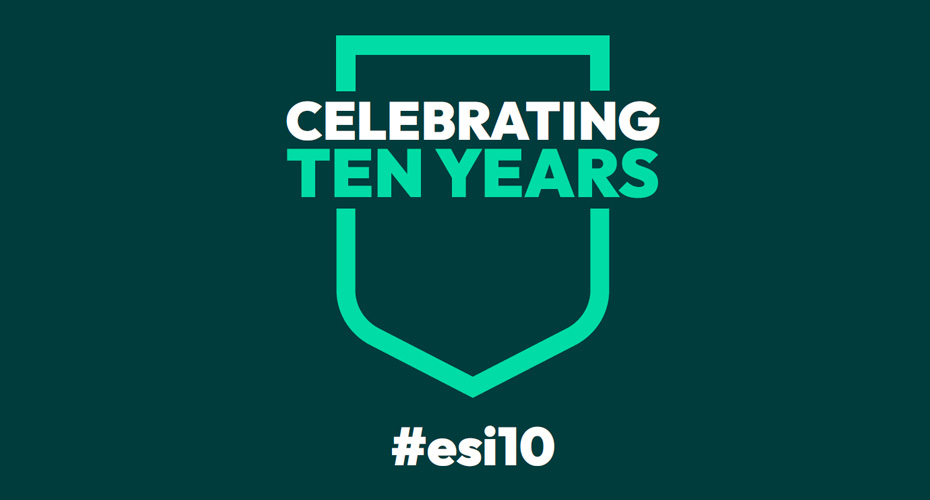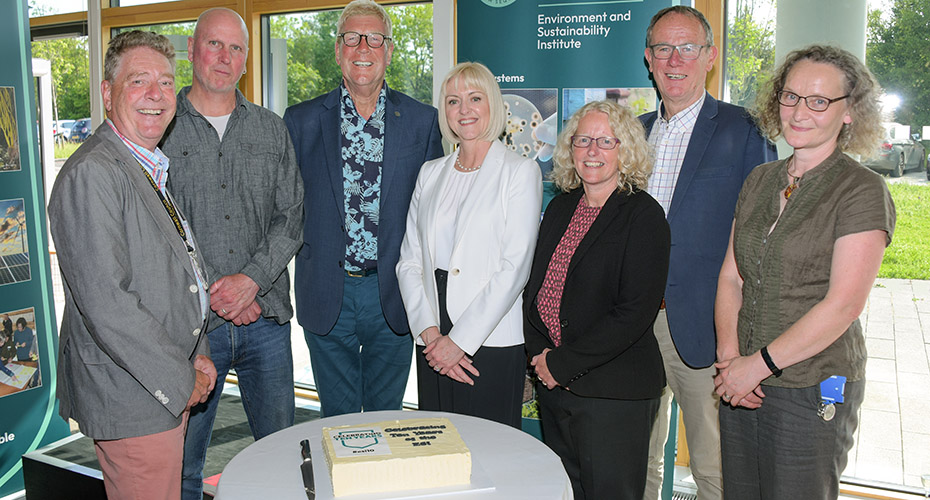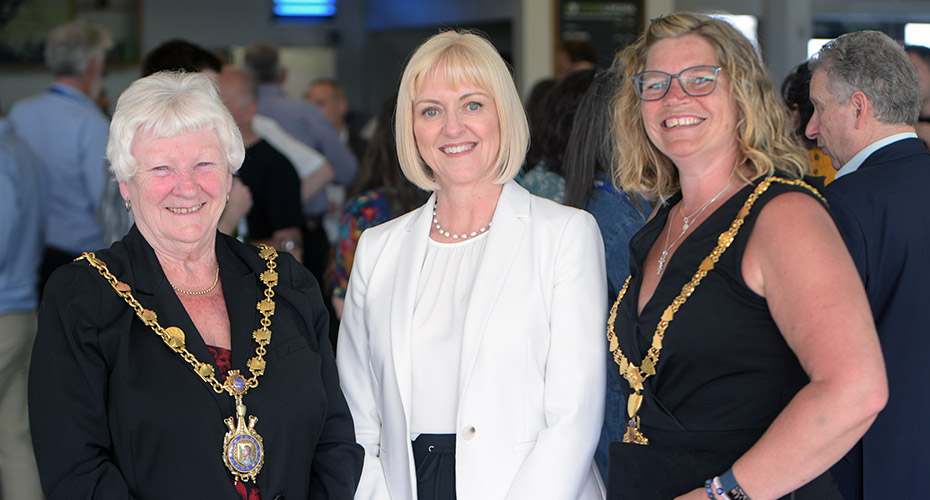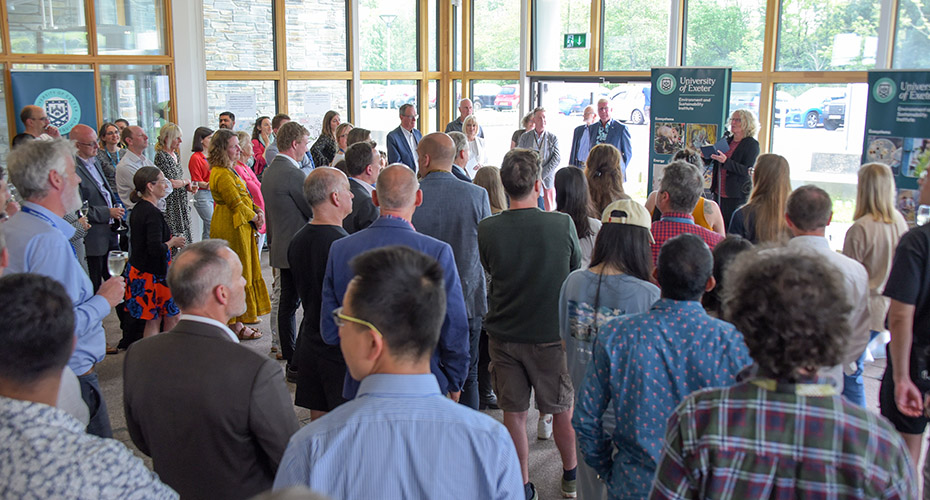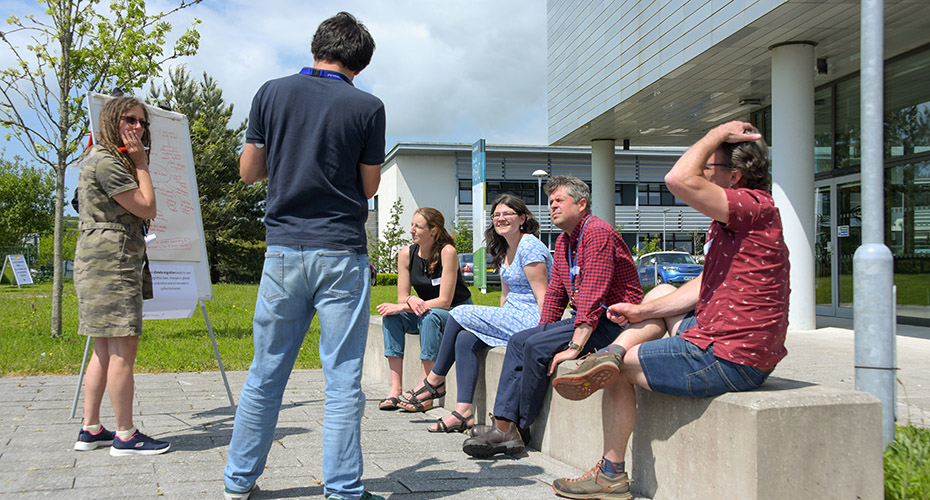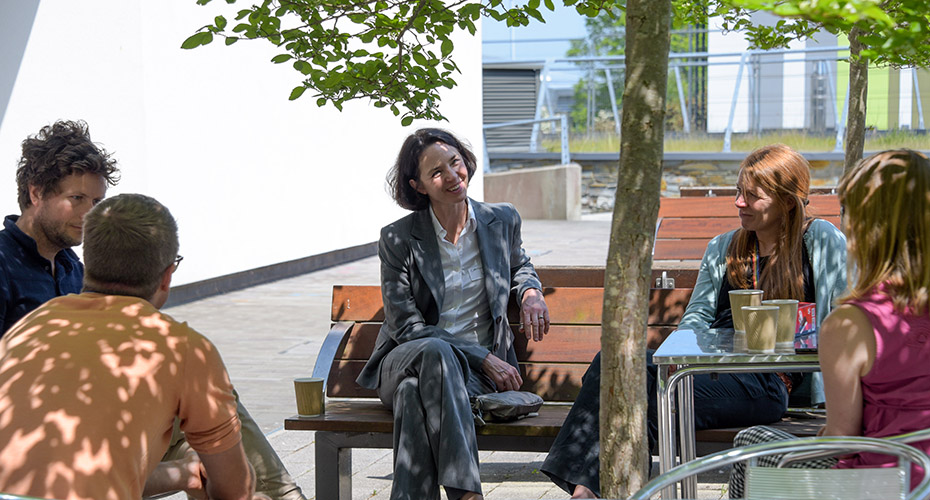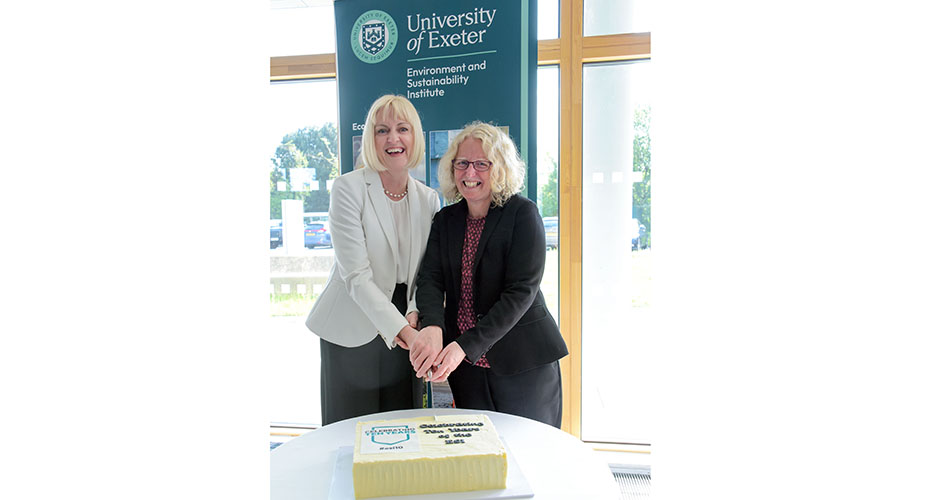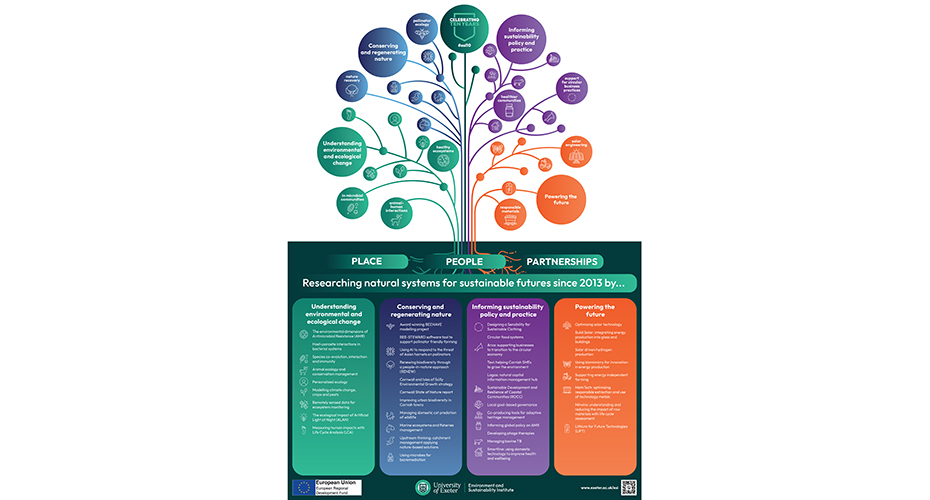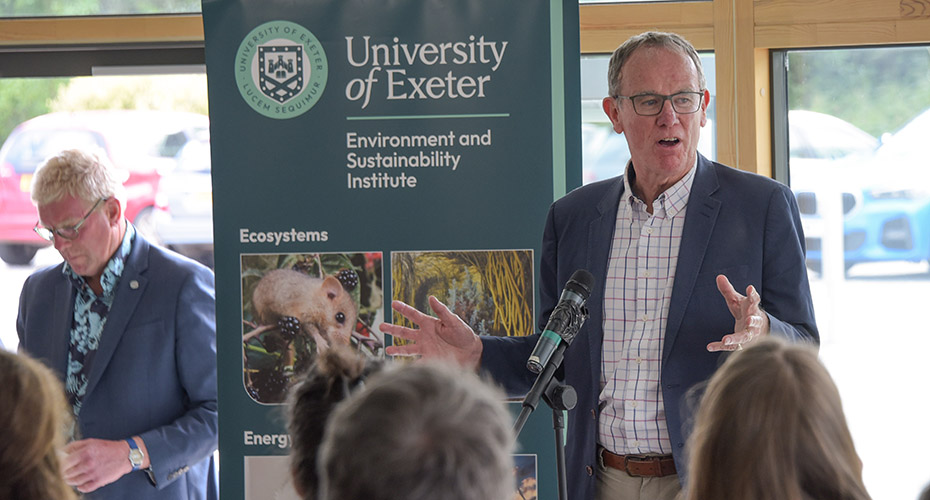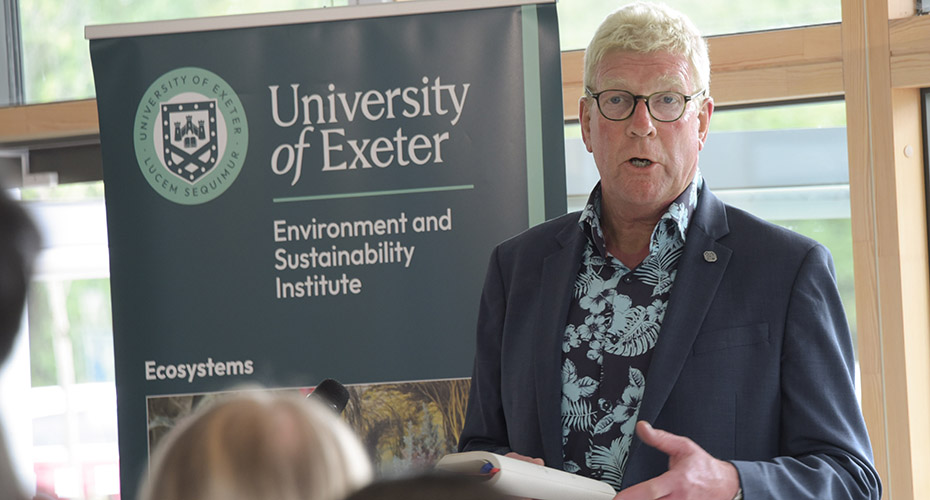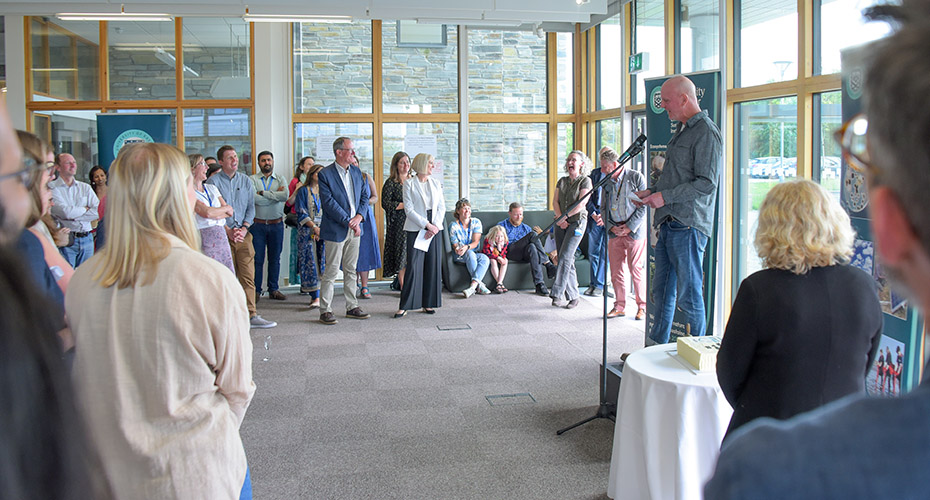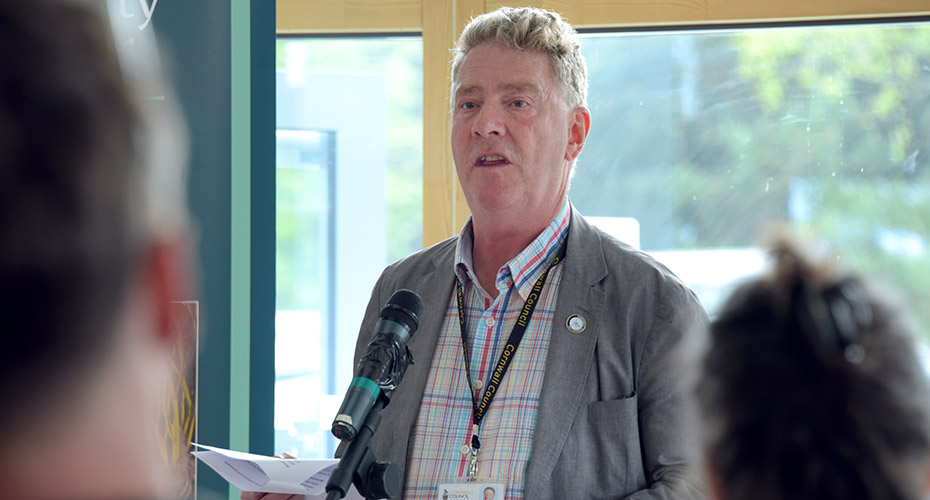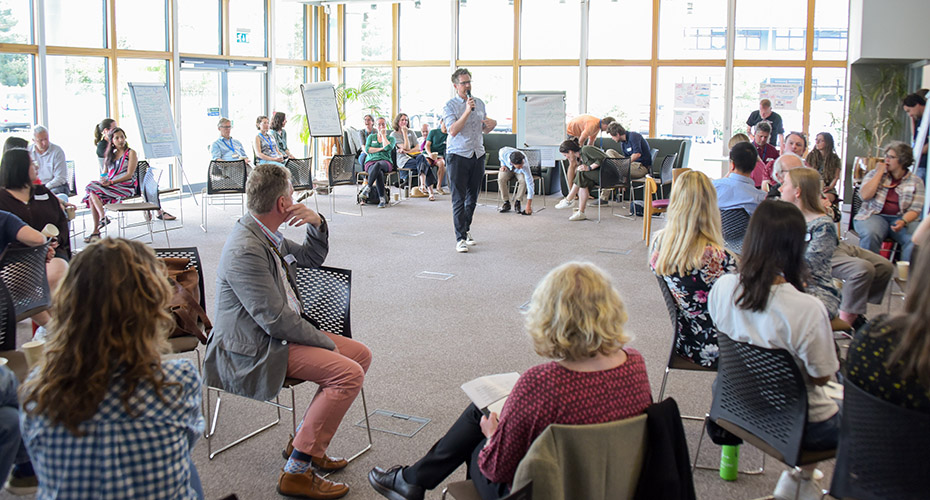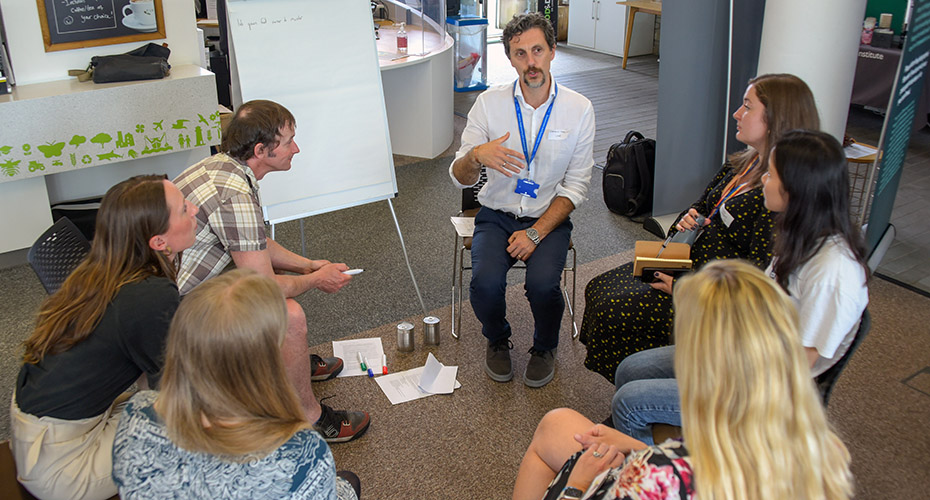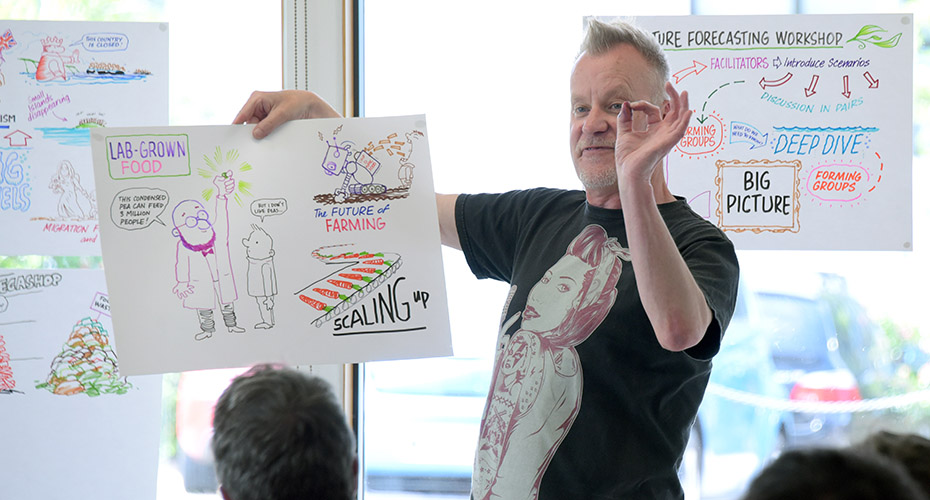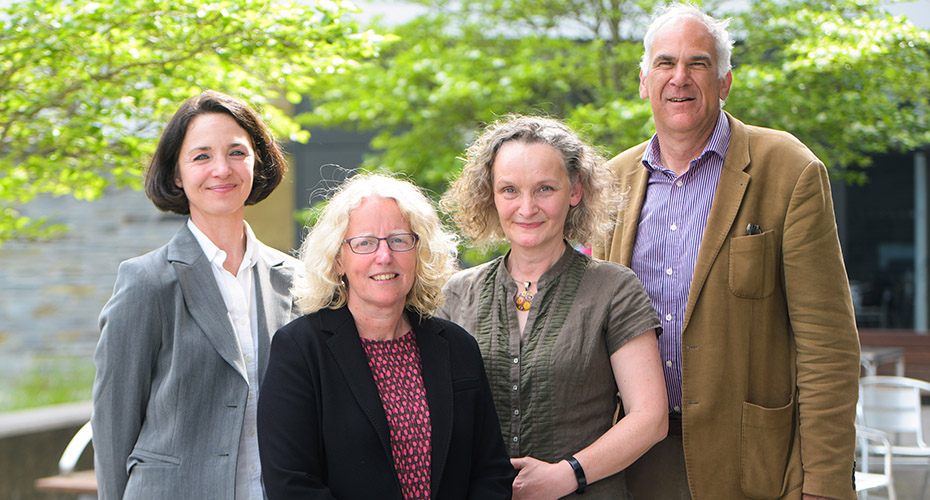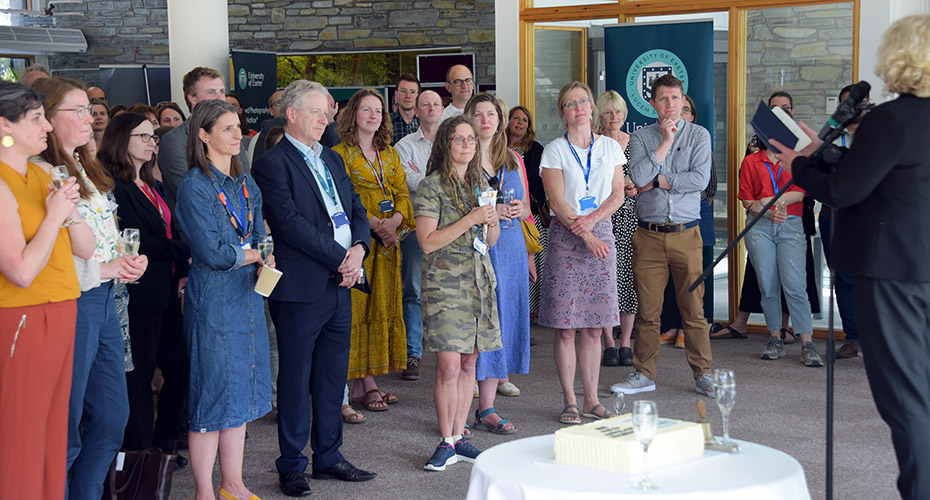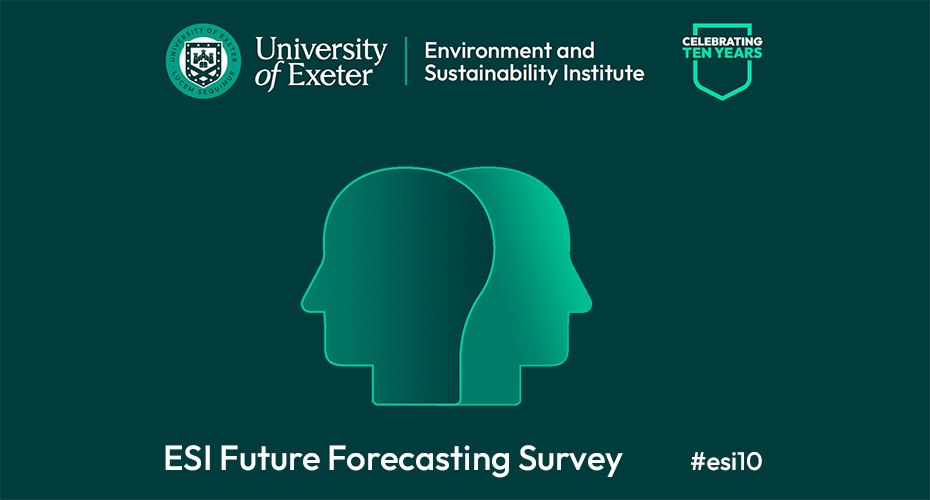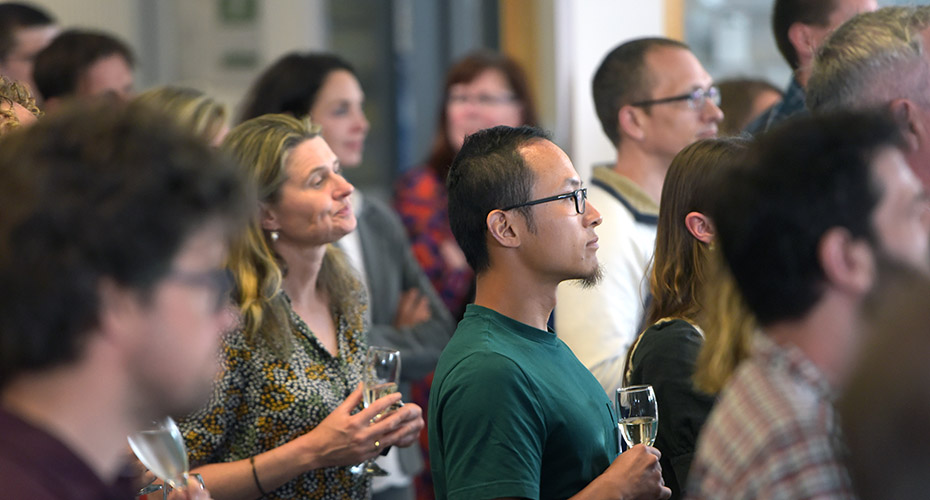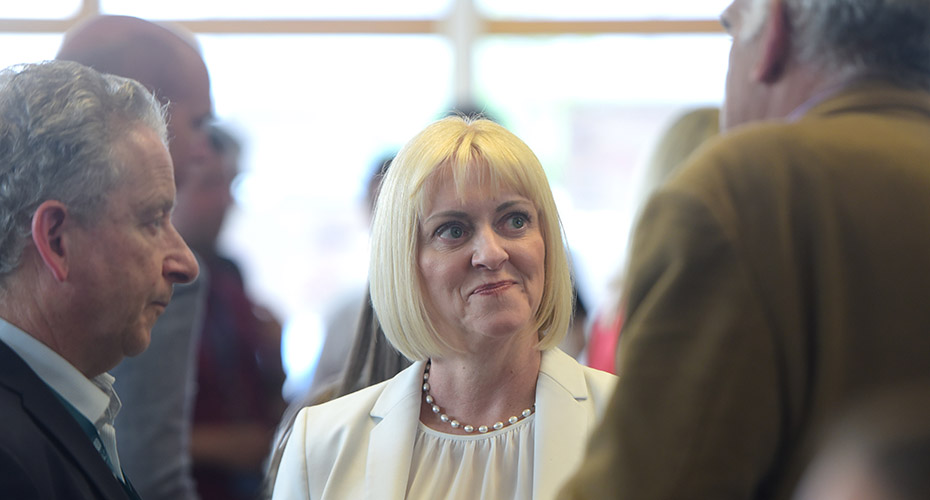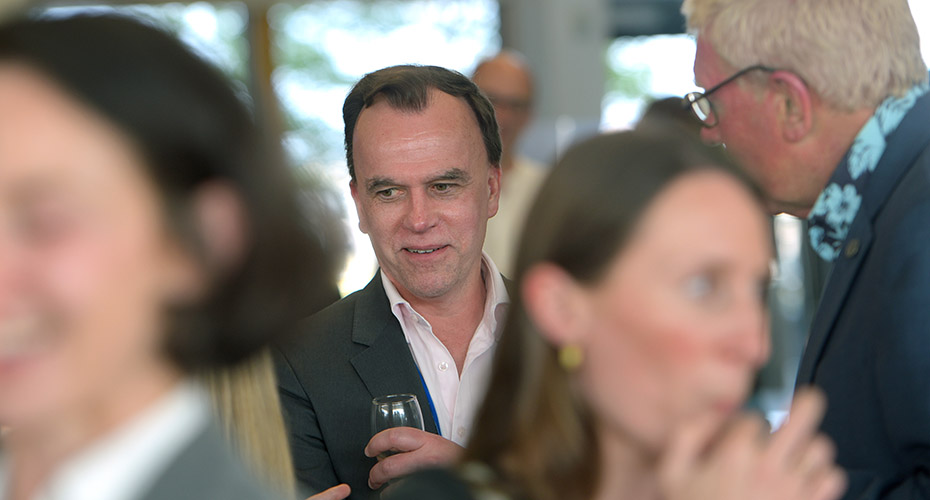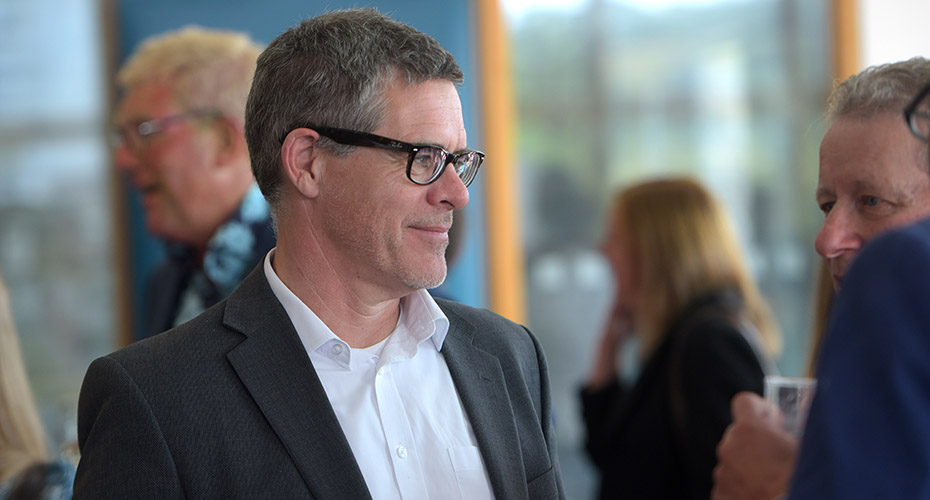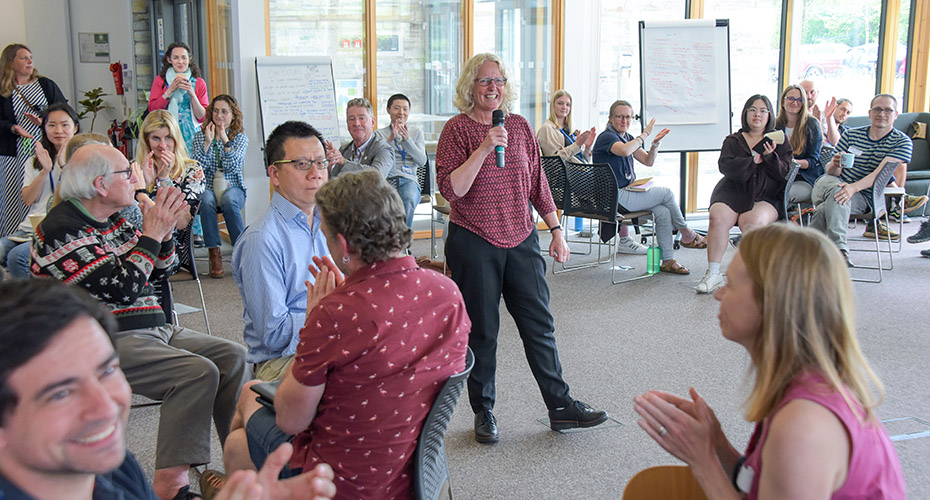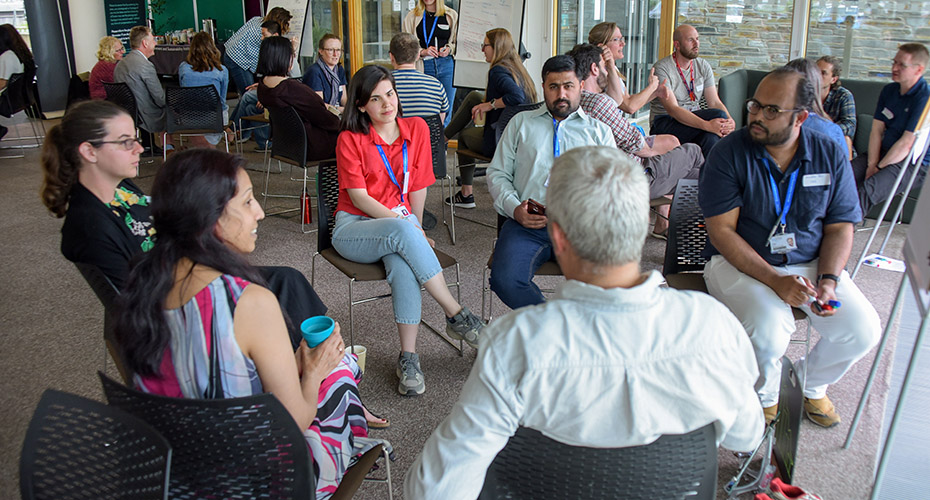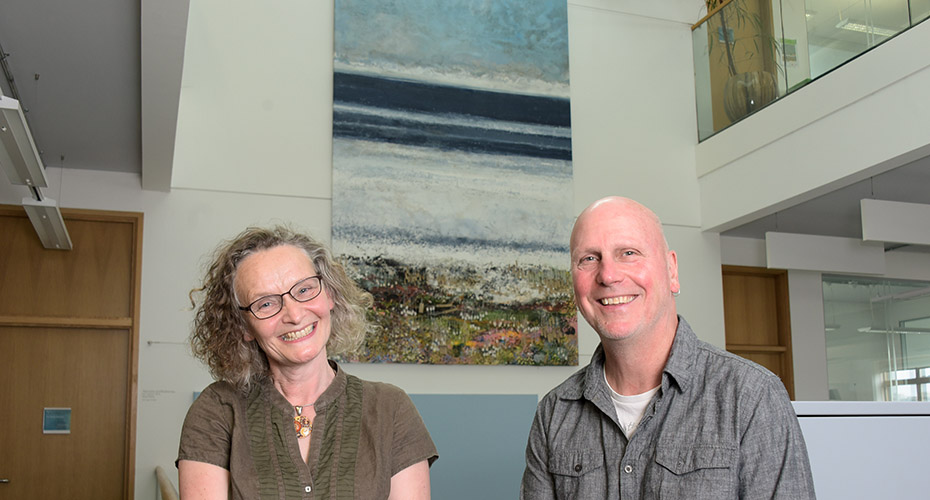Retrospective and a look ahead to the next 10 years
esi10 Party Celebrations
Thursday 25 May 2023
1 - 3pm: Interactive facilitated workshops
4 - 7pm: Celebratory party
On Thursday 25 May, the ESI celebrated its 10 year Anniversary. The team held an interactive workshop to explore 10 emerging issues that will shape the research agenda for the next decade. They also launched an infographic to capture the work completed during the last 10 years before having a party with 160 guests. Speeches were made by Lord Robin Teverson (Chair of the CIOS Local Nature Partnership), Kim Conchie (CEO of the Cornwall Chamber of Commerce), and Martyn Alvey (portfolio holder for the Environment and Climate Change in Cornwall Council’s Cabinet). Formal proceedings were closed by our Vice Chancellor Prof Lisa Roberts and Director Prof Jane Wills cutting a celebratory cake.
The event also provided an opportunity for the ESI team to publicly thank Kurt and Caroline Jackson for the donation of the painting ‘Biodiversity and Taxonomy’ which hangs in the atrium of the building. It is a remarkable work that speaks to the ESI’s work to conserve and regenerate nature.
The day rounded off with a party, sharing food, drink and live music with a wonderful diversity of guests from within and beyond the university community. It was a lovely opportunity to catch up with old and new friends.
 |
Lord Robin Teverson, Chair of the CIOS Local Nature Partnership, is similarly active in relation to environmental issues in the Houses of Parliament, this time, for the House of Lords. He has been supporting nature recovery in Cornwall and the Isles of Scilly for many years and will reflect on the achievements and challenges of work in this field. |
 |
Kim Conchie, the CEO of the Cornwall Chamber of Commerce, will pick up on our themes from the perspective of the business community. Kim has led a pioneering programme of work to engage businesses in nature recovery and will share his insights about this work. |
 |
Councillor Martyn Alvey is portfolio holder for the Environment and Climate Change in Cornwall Council’s Cabinet. He will reflect on his ambitions for Cornwall and its wider community in continuing to lead important policy innovation and activity in this area. |
 |
We are also pleased that our previous ESI Director, Professor Juliet Osborne, will be publicly thanking Cornish artist Kurt Jackson who has very kindly donated his painting entitled ‘Biodiversity and Taxonomy’ to the University of Exeter. We are very grateful for his interest and support. |
 |
Vice Chancellor, Professor Lisa Roberts, will be reflecting on the past and looking to the future of the ESI. She will end by cutting a celebratory cake and raising a toast to everyone who has supported the ESI over the past decade. |

View our new Tree Infographic celebrating the impact of the Environmental and Sustainability Insititute's first decade of successful operation.
View the results of our interactive workshop which explored the 10 emerging issues that could provide an opportunity for interdisciplinary responses from the ESI community over the next decade.
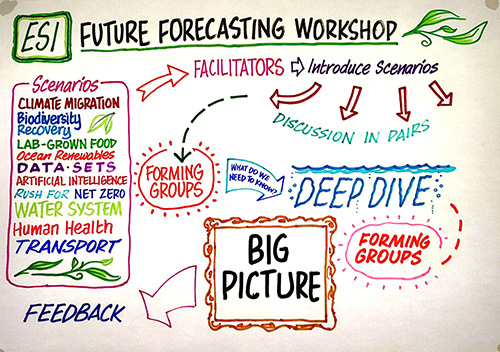
The rush for net zero has unintended consequences in relation to resources, community well-being and ecosystems, and raises questions about its achievability.
Prof Ilya Maclean and Dr Anurag Roy
During the workshop's first session, participants delved deep into various challenges related to achieving net zero. The discussions covered a wide range of topics, including resource management, security risks, governance issues, circular economy, undiscovered technologies, hidden obstacles, and more. These stimulating discussions involved diverse group members from business schools, Cornish mines, ecologists, chemists, and technologists. The insights gained from these discussions will significantly influence future research and development endeavours at ESI.
The second session, titled "Big Pictures," was equally remarkable. It brought together a younger group of participants, including ECRs (Early Career Researchers) and PhD students. This session focused on implementing solid policies and promoting research to achieve net zero. The dynamic discussions within the ECR session highlighted the diverse challenges faced by different countries, encompassing economic, cultural, and political aspects that threaten to achieve net zero targets. Several key themes emerged from these discussions, such as the notion of "rush for net zero" being perceived as impossible, blame games, security concerns, high risks, and the importance of equality.
Ensuring that the United Kingdom ceases its contribution to global warming by 2050 is a paramount goal. This theme should be incorporated into our academic courses, allowing for the integration of the challenge into subjects such as Science, Geography, or Social Studies, both in traditional classroom settings and through remote learning methods.
Achieving this new goal will pose significant challenges, as it requires a complete phase-out of fossil fuels, including natural gas, diesel, and petrol. In this context, carbon neutrality represents a present state, signifying a point of "economic" neutrality. It typically involves the purchase of carbon credits for offsetting purposes and can extend beyond neutrality, encompassing concepts such as Climate Positive.
On the other hand, the term "Net-Zero" is employed as a distinct, science-based transition target. It involves genuine reductions in emissions undertaken by the organization, aligning with recognized climate science scenarios. To address any residual emissions in the future, suitable measures, including the use of carbon credits or offsets, may be employed to maintain balance.
These discussions' outcomes will catalyse accelerated research and technological developments at ESI. By focusing on current challenges and adopting a more sustainable approach, we can contribute to the betterment of society and enhance the pride of the University of Exeter.
Forced climate migration leads to new immigration laws, changes in global co-ordination and an increase in authoritarianism.
Prof Clare Saunders and Dr Tiago De Melo Cartaxo
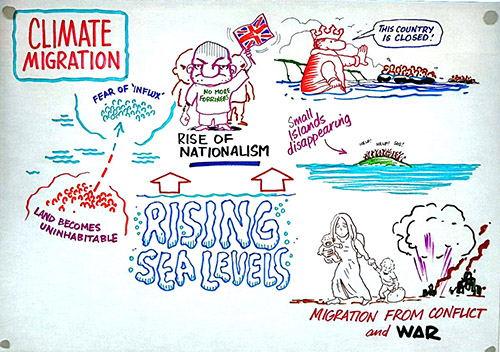
This is a complex scenario, illustrative of the entanglements between political systems, environmental conditions and people at multiple levels. It is also conceptually messy. What does it mean to migrate because of the climate? Is it the same as being a refugee? Why not? At one extreme we might see it as a choice of the wealthy and educated who understand the dangers of future sea-level rise; at another we could conceive of it as enforced population movements due to ecological displacement. Existing inequalities mean that serious social justice ramifications will ensue. It is important to note that the term migrant is often viewed in a derogatory way in many countries in Europe, fuelled by right-wing populist discourse. International law does not currently recognise the environmentally displaced as refugees, which means they are currently denied rights to claim asylum; and therefore play into anti-migrant sentiment. Such sentiment is a common feature of right-wing and authoritarian regimes that also bolster strong pride nationalism. Even in the UK, it is common for many people to blame poor public services on an influx of “foreigners”. The worry is that mass ecological displacement from climate change sits difficultly alongside the rise in authoritarian regimes and populist right-wing governments, even in countries hitherto deemed advanced industrial republics; perhaps even bolstering them.
What can we do to solve these problems? Interdisciplinary work is crucial. Political scientists need to work together on understanding how and why right wing populist movements and parties are so popular; and to find ways to halt and reverse the rise of authoritarianism in ways that do not reek of authoritarianism themselves. Lawyers and political theorists must draw up conceptually sound definitions of climate migrants (or refugees), or the ecologically displaced and work with NGOs to get definitions internationally recognised. Environmental scientists need to be able to understand – and predict – when and why environments become too inhospitable for human life. Human and cultural geographers need to work with all of these partners in planning solutions for mass movements of displaced people. Migration studies can help understand what the social and political conditions are for favourable acceptance of victims of forced migration.
Rapid implementation of landscape-scale biodiversity recovery generates concerns about the balance of natural and cultural benefits and interests, and the tension between managing for ecological restoration versus embracing novel ecosystems.
Prof Juliet Osborne and Tanya Venture
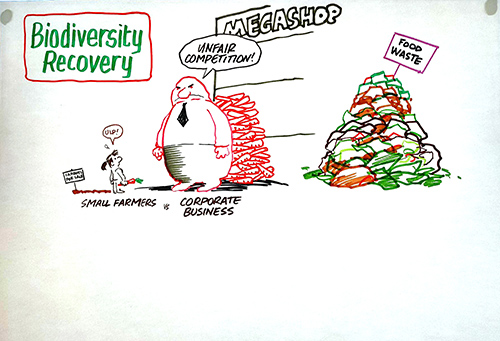
We discussed the potential conflicts that might arise from biodiversity restoration schemes and these tended to be conflicts with other cultural and social needs and activities – such as food production; aspects of the built environment ( roads, rail and housing) and the needs and cultural aspects of local communities – across the UK and across the world; including the rights and needs of indigenous peoples.
In our deep dive, there was general agreement that conflict often arises when biodiversity restoration schemes are “imposed” by either government, public bodies or businesses without fully taking the communities views and needs into account. This was illustrated with examples of the impact of environmental schemes on the farming community; the purchase of swathes of land in the tropics for biodiversity or carbon offsetting; and transformation of some public spaces in built environments.
The point was also made that with proper engagement and co-creation of schemes – then multiple benefits aside from biodiversity restoration can be achieved connecting communities with ecosystems. In discussing the “big picture” the themes resonated very strongly with the deep dive. It was recognised that conflict between cultural needs and the need to restore biodiversity can be “baked in” if the local context is not considered centrally in any plans.
There is always a challenge that different actors are working to different “baselines” for biodiversity and confusion and conflict can arise about what we are trying to restore and why. Stronger locally-based “environmental governance” was offered as a solution to avoid some of the conflict – rather than “experts / scientists” imposing a plan based on the scientific knowledge of site and species. It was recognised that such consultation, co-production and development can take a very long time but may result in better context-dependent outcomes for people and nature.
The key words for making future progress to avoid conflicts between biodiversity restoration and the needs of people were democratise, accommodate, educate and ensure that we consider the needs of different communities at a local scale - across the globe.
Continuing investment in ever growing and overlapping data sets (e.g. satellite data and bioinformatics) fails to consider the environmental consequences of that data across its acquisition, storage, and life cycle.
Dr Karen Anderson, Ruby Wilkinson and Magda Mleczko
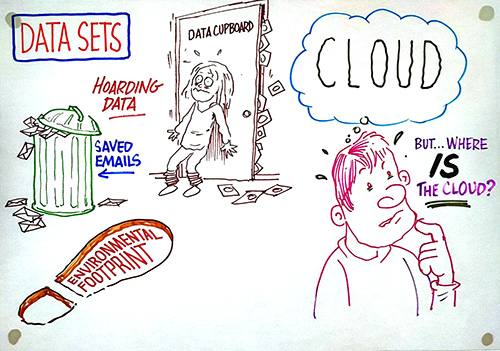
Initial framing questions in the discussion included ‘what will the future of data be?’, ‘how much data do we need?’, and ‘where is the data kept?’ The environmental implications are hard to identify, including carbon impacts and use of minerals. But the human consequences are equally unclear, including the security of our data and the increasing or decreasing costs of storage.
The gaps in our knowledge emerged around how we should approach the practicalities and ethics of capturing and storing data. For example, is it better to host data on larger or smaller infrastructure? Do we need more satellites, and if so what are the territorial and power implications? What are the different carbon intensities of data storage held in different countries?
The potential consequences are vast, both to the environment and to society.What data is kept, where, and by whom, is often a mystery. But the impacts could be ‘horrifying.’ How can we quantify the amount of energy utilised for data? Is data ever really deleted? Who has access to the data, and who are the gatekeepers, who owns it? We can currently see domination by a small number of corporations, e.g. Google, Microsoft Azure.
To make process, a vital step is to quantify the process of capturing, storing and using data in order to enable informed choices to be made. To do this, we need a collective agreement that there is an issue. This agreement could be framed around the unknowns with data sets, as well as issues of ownership and privacy, and the legacy of data. Genuine choice will also require an option of ‘green cloud computing’, where the resources required, location of the data centre, and the commercial motivations are made transparent.
Fundamentally, we need to be asking more questions, about the architecture, scale, life cycle and hidden costs of data. Meanwhile our relationship with data needs to shift, including how we are using and replicating data, and our reluctance to truly delete it.
Significant investment in ocean renewables sees a rise in floating offshore wind and other technologies. The lifecycle of these technologies impacts on ecological systems, biodiversity, and the use of critical minerals.
Prof Xiaoyu Yan and Molly Kressler
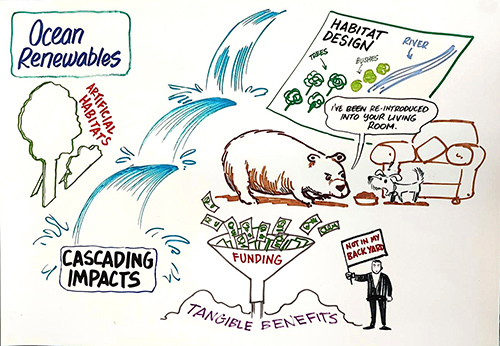
Common questions or unknowns around the growth of ocean renewables are focused around the immediate and potential impacts, and the resources required to develop them. Key impacts include biodiversity, for example disruption to seabird species or the potential to create new artificial habitats, and society, through fluctuations in energy prices and attitudes towards turbines. The necessary resources raise significant concerns around the scale and source of funding, the carbon and ecological impacts of the critical minerals required, and the lifecycles of the entire supply chain.
Our response to these questions and concerns is often based on unknowns, including potential cascading impacts exacerbated by the rush to net zero, and decision-making and public opinion based on binary choices or visual biases in what we prioritise or resist.
A key question emerging is how to make equitable decisions, including the economy, social and cultural concerns, and the environment, while acknowledging that these are all intrinsically linked. We need a systems understanding, facilitated by the financial sector, that incorporates the needs of ecology, the fishing community, policy demands and other regional and national concerns.
This holistic approach requires different perspectives to inform the growth of these technologies. What are the different degrees of impact of the lifecycle effects on wildlife, for example? How do the economic impacts manifest through the infrastructure of renewables, as well as the supply chains, and the skills needed to build and maintain them?
Resilience emerged as a common thread in this discussion, both in terms of the contribution to community resilience and the environmental resilience necessitated to maintain a systemic balance in the ecosystem. A key concern for communities is who gets the power when it is generated? Does that energy support local areas, or is it taken elsewhere? Are jobs sourced locally, or are skills brought in from other areas? This can lead to increased inequity driven by infrastructure and policy.
We also need to consider where the resources will come from, including magnets, and a high concentration of rare earth deposits. Many places are ‘gearing up’ to harvest these resources, and this activity will have significant impact on local areas both socially and environmentally. We need to better understand how to reuse and recover resources such as metals from ‘dead’ technology, and how to make it economically viable. These systemic approaches are vital to ensuring that the expansion in ocean renewables creates resilience rather than systemic degradation.
A boom in lab-grown food impacts the way that food is owned, distributed, and consumed, with significant concerns about public health and the future of agriculture.
Prof Stefano Pascucci and Dr Daniel Cox
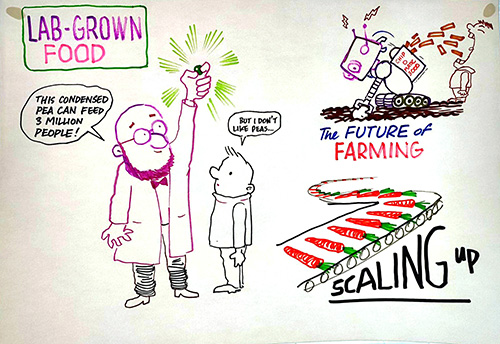
The growth of lab-grown food raises questions about gaps in our ability to consistently define aspects of our food system. For example, what counts as farming? Lab-grown food is seen as non-traditional, and therefore related to change or diversification. Are new business models required? What is the future of place-based food production? What are the reasons that there are not more chefs promoting lab-based food, or asking questions publicly?
Other questions emerge as well, including the impact on new food systems on food justice, and who is likely to be impacted by shifts in practices. Health and environmental impacts are significant, and unlikely to be felt equally. Will inequalities in the current system be replicated in the new one? Food production requires intensive use of energy, water and land. Which communities and ecosystems will be most impacted, and how will those decisions be made? There is concern over the rise of multi-national monopolies dominating the provision of lab-grown food.
The scaling up of lab-grown food also raises complex uncertainties, especially in the social implications. What food futures do ‘we’ want? Are we consumers or citizens in this process? What do we know about what we eat, and how much do we think we already know, or want to know? How will labelling work, what will the choice look like in practice? The framing of the issue is crucial, and transparency of ownership is a real concern. How will political views impact our perspective of decision and rule making around these technologies?
Can we even define what lab-grown food means? What is a lab? Is it simply a ‘controlled’ environment? What are the boundaries around the idea? Is it artificial, safe, contaminated? Is it non-natural? One definition of a ‘food-lab’ is as a ‘complex’ and ‘interconnected’ environment. The framing of these spaces is significant. A negative framing is very possible, triggering existing views around mass control and conspiracy.
To respond to this risk, we need to better understand the reality of the system. What are the current and potential impact, for example on water use, other resources, and pollution? What is the realistic scalability of lab-grown food? How will the rate of change affect infrastructure, policy, and social opinion? What are the wider social consequences on jobs, communities etc.? There is strong potential for the ESI to become more involved in policy, with a strong position to provide guidance.
Our water system reaches a tipping point, dramatically impacting availability of water, and increasing the potential for desertification, flooding, and desalination, with associated health and ecosystem impacts.
Prof Will Gaze and Sarah Sutcliffe
We are already seeing significant change – water bans, increased bills, sewage and pollution. But there are other equally important issues that should frame research into the water system. Who does, and should, own water? Is it a commodity, or a right? Who defines the goals and targets of how water is used? Is the current system serving both society and the environment?
From a human perspective, many issues need unpacking. Water affects and is affected by anti-microbial resistance, migration driven by scarcity (this also affects animals), where housing can be built and how resilient it is. It affects food security, through crops and food production, grey water irrigation, energy and infrastructure costs.
Questions of scale are also important. How do the local and global patterns or supply intersect? What are the relative geopolitics of water ownership, quality, and access. What are the potential conflicts that may arise as a result? This leads to issues of equity, including the ethics of who gets water, the ethics of researchers working with different groups, and the dichotomy between state and public owned water infrastructure and existing or potential monopolies.
As well as a human right to water, the environment itself has rights. Different understandings and appreciations of the environment and its value create different ethics and perspectives which must be balanced and understood. Water creates a clear link between human and environmental health, particularly around sewage and other forms of pollution.
The potential impacts of the future water system are complex, permeating into issues of justice and colonialism, as well as behaviour change and health. The consequences are simultaneously local, affecting economics and infrastructure, and global, contributing to the climate emergency and conservation efforts. More work is needed to identify and influence the key actors, from corporations to individuals, and the multiple levers required for change. The role of UK researchers working on global issues such as the water system still needs further unpacking.
The multifaceted benefits of public transport and active travel lead to a dramatic increase in incentivisation from employers and governments, impacting on local and national trends in the role of journeys in our lives.
Dr Tom Chaigneau and Dr Dan Padfield
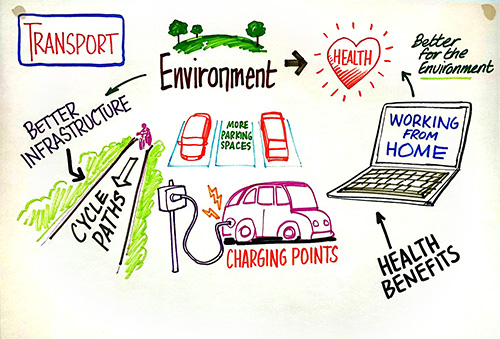
Considering the future of transport begins with a dynamic between institutions, creating infrastructure and policies, and the individual, with their intrinsic motivations and behavioural choices.
Foreseeable consequences of an increase in public transport and public travel are multifaceted. Where will the money come from? Increased taxes, or corporate interests? Could investment generate more public and local funds? Is an enforced loss of lifestyle choice fair or just? Would the shift be detrimental to elderly and disabled people? What would be the impact on economic and social productivity?
To unpack these implications, we need a deeper and more comprehensive synthesis of research across disciplines. We also need a more informed understanding of the currency of the different evidence available, including currencies of economics, environmental impact, and of wellbeing.
We also need to consider what we are missing in our current assumptions of the potential future scenarios and consequences. What would be the difference between a gradual change and a strong push towards a new transport system? Who benefits and who loses out? What would it do to the rural/urban divide? Should there be context-specific strategies in place?
We also need to be clear about why this is a potential scenario. It seems like a relatively ‘easy win’ for positive social and environmental change. But we also want to better understand why it’s not easier to get to this future more quickly and clearly.
To do all this, we need to foster new connections. We need to learn from urban city centres, conduct more pilot studies, work with young people, share data with travel companies, and consider novel solutions such as on-demand bus services. We can also do further research into novel tipping points and moments of change that will lead us to a more socially and environmentally resilient transport system.
Changes in pollution, antibiotic use, and food quality affect human health, necessitating changes in public health approaches as new risks and responses emerge.
Prof Stineke Van Houte and Dr Kelly Thornber
The impacts of this scenario have potential consequences at both local and global scales, and are essentially underpinned by the consequences of historical and ongoing unsustainable development. Social inequality is beingaccelerated by these factors, with impacts distributed unevenly and predominantly affecting Low and Middle Income Countries (LMICs) and more socially-deprived regions of High Income Countries.Rates of non-communicable diseases (for example obesity, diabetes and cancer)are rising due to exposure to factors such as pollution, pathogens and poor food quality. Antimicrobial pollutants are fuelling the ongoing rise of anti-microbial resistance (AMR), and wider pollution is contributing to global biodiversity loss.
We have a number of knowledge gaps and new connections that need to be bridged if we are to adequately respond to this scenario. For example, more responsible governance is needed, such as for pharmaceutical (including antimicrobial)use, at both a global scale as well as within individual countries. We need to accelerate access to funding to better understand the nature of the impacts of these issues on human health, environmental health and the economy,and in particular quantify them and integrate with concerted action towardsthe Sustainable Development Goals (SDGs).
One particular aspect of human health emerging from discussions was the link with food quality.
The idea of personalized medicine and tailored diets arose as a potential solution to human health, in particular to restoring microbiome disturbances, for examplefollowing antibiotic use or poor diet. We identifiedthe importanceof communities in supporting healthier lifestyles and better food quality, as well as a clear need to focus on preventing disease to reduce the need for drugs. We also have a need for better data to understand the links between the environmental (including pollution), poor food quality and human health, to help inform change strategies, and good storytelling to go with this to help people relate to these issues, and we need better collaboration between different sectors.
Growing use of Artificial Intelligence impacts how we experience and respond to nature, how research takes place, and how policy decisions are made.
Dr Markus Mueller and Dr Benjamin Phillips
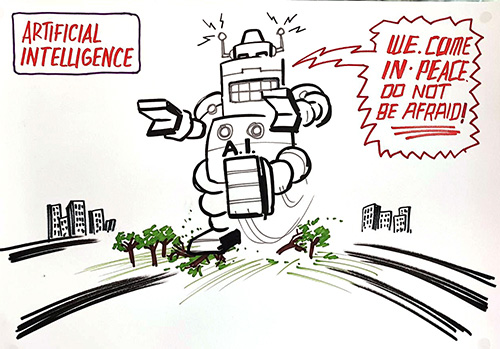
We are already seeing AI being used in research, including within the ESI. For example, using image and pattern recognition for identifying insects, optimising optical designs of photovoltaics inspired by nature, or adaptive population management in conservation.
AI clearly has enormous potential to dramatically alter the research landscape, particularly in terms of the amount of data that can be harnessed, and the speed of which it can be used.
The increase in the use of AI has both positive and negative potential impacts on the environment. For example, it could reduce the need for human disturbance by enabling more remote monitoring and responding. However there is also a strong potential for negative unintended consequences, including increasing energy consumption by harnessing big data approaches and computing resources.
There are also many other general concerns around potential trends, particularly with regard to the equity and power dynamics of AI. Who is designing/controlling AI systems? What are the key interests of (large) corporations that develop AI? What are the underlying biases of the AI and the data on which AI systems are based/trained? How can biases be addressed or overcome?
There is an enormous potential for wide-spread use of AI to support processes, including image recognition and ChatGPT, while at the same large parts of the populous may be excluded due to knowledge gaps in what AI is and what it can do.
Fundamentally, there is a clear need for regulation. Who is regulating AI developments and its use? How can regulation keep up with development? How can regulation be pro-active to be effective?

